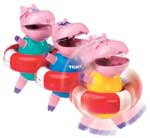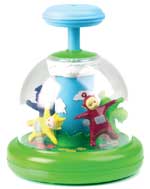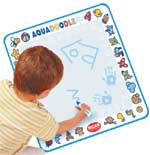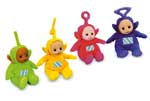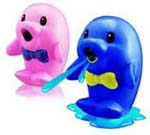|
|||
| Introduction | |||
| Childhood games and toys | |||
| TOYS AND THE STIMULATION OF INTELLIGENCE If we analyze the theory of the multiple intelligences, outlined by H. Gardner, we observe that he conceives intelligence in terms of results and the abilities required, so he defines it as the capacity to solve problems and to create products in a natural and enrichened atmosphere. The seven types of intelligence are defined, according to Gardner, to meet criteria or basic requirements that outline it as an integral structure, and make them different from talent, aptitude or ability. We are not trying to assess these requirements in this essay, as Gardner’s books can be consulted for this purpose. The important thing is that these intelligences outline certain operations and abilities that characterize them, and as the individuals use them to solve problems and to elaborate products, they are geared to the results of the process.
These results will be closely linked with the means that the setting provides for their attainment; they are materialized in different signs, symbols and objects that stimulate them and foster their development. It is in that sense that toys begin to play an important role, as they are part of the experiences (that stimulate the development of intelligences) if they are well chosen to activate each type of them. This theory states that in each person coexist seven types of intelligence, although not all of them at the same level of development; most of the children can develop each one of these intelligences. These intelligences work together in a complex way, and there are a lot of ways to be intelligent in each category. These statements combine consequently with the possibilities offered by real life objects for their appropriate stimulation. When toys are assessed from the perspective of a development process of psychological and physical qualities, they can exert a stimulating action on those features that constitute the central nucleus of these intelligences, of those directly related with the specific type of toys, although, being consequent with Gardner and the historical-cultural theory, all objects exercise an action over all processes and psychological actions, based on the conception of the dynamic localization of the brain functions. Therefore, when classifying a toy within a type of intelligence, it is based on their main function, and not on an exclusive categorization of the type of intelligence. Based on this classification, and on the knowledge of the development and particularities of children in these ages, and of the evolutionary specificity of each intelligence, a selection is established for each stage of development, avoiding a closed categorization by ages. This way, by conjugating all the parameters, we achieve a more scientific focus for the classification of the toys and their effects in the intelligence. In the following lines you will read about some appropriate toys for each intelligence type, remembering that they don't constitute all those possible ones for each classification. Toys for the development of linguistic intelligence
Toys with voices and sounds in a computer format, interactive puppets, telephones with voices, microphones karaoke, representative toys of means of transport: (airplane, bus, car, car), objects that represent real life tools, marionettes, books of texts and images, wooden animals, plastic and teddy bears, coffee, kitchen, room, dining room, sets, cleaning and working tools, toys for role plays: doctor, barber, mechanic, carpenter, their means and instruments, construction games, printing sets, traffic games, wooden horse, ball, domino sets of animals, colors, fruits and vegetables, means of transport, etc., surprise boxes, record player, rope toys, costumes, doll houses, table games, lotteries, television of images, group games: monopoly, etc., card games, elastic band of sound plastic balls, toy mirrors, and all those that stimulate the use of the word in practical situations. Toys for the development of logical-mathematical intelligence. Educational electronic toys of all types, preferably with graphic demonstrations that demonstrate problem solving, calculation, assembling games, advanced toys of drawing, logical, numerical puzzles, of diverse groups, comparison, classification, identification, models and planes, toy compasses, riddles, inclusion games: of colors, shapes, sizes, toy calculators, threads, scientific instruments, pyramid, boxes of shapes and colors, wooden and plastic geometric figures, mechanical and rope toys, electronic dominoes of letters and numbers, architect's games, manufacturers, rubber stamps of different figures, building games, tool kits, and all those that imply the understanding of quantitative relationships and logical patterns. Toys for the development of spatial intelligence Games of radio control, crawlers, engagement games, boards, electronic games with graphics, puzzles of images: animals, plants, landscapes, mosaics of shapes and colors, of geometric figures, animals, labyrinths, blocks, books of images, toy computers with activities of drawings, coloring books, cut outs and fill-in the blanks, play dough, ball, pyramids, inclusion games: geometric shapes, animals, objects, etc., cut out boards with figures, molds, sets of rings, models of airplanes, ships and other means of transport, construction cubes, color dice, water colors, color pencils, crayons, rattles, mobiles, videos, light toys, kaleidoscopes, transformers, and some others that allow the representation of images and space, shape, color and line interrelations. Toys for physical–kinesthetic intelligence
Pull toys, crawlers, drawing screens, construction and assembling sets, carrousels, swings, toys for outdoor games, stairways, tricycle, carts, mini-cars, play dough, drawing games, of construction, cube and shovel, hammer, balls, scissors, wheelbarrow, plastic or wooden horse, baby rattle, set of rings, arch and arrows, target shooting, racket, skates, diverse tool kits, fishing rod, spinning top, soap bubbles, molds to play with sand, Chinese sticks, watering-can, strings, balls, big hoops, surprise envelopes, and all those ones that promote body sensations of physical balance or manual learning. Toys for musical intelligence
Educational electronic toys with sounds and musical rhythms, microphone of imitative games, Discman, radio and record player, musical instruments: guitar, harmonica, xylophone, piano, bugle, percussion teams: drums, tambourine, rattle and other sound objects, music boxes, recorders, cassettes and cd player, diverse bells, flutes and whistles, maracas, keys, bells, Chinese box, triangle, radio and toy record player, marimba, castanets, cicadas, sound mobiles, walkman, and those toys that allow to perceive harmonic and musical sounds. Toys for the development of interpersonal intelligence Diverse table games: monopoly, lottery, dominoes, toys for collective activities: tools and work implements, wheelbarrow, costumes, tent, bus and mini-cars, accessories for imitation games: doll, animals of plastic, wood and teddy bears, marionettes, dining room, bedroom, school, sets, balls and baskets, cleaning tools, hairdresser sets, long pikes, carrousel and other outdoor games, puppet theater, and all the other toys that facilitate social communication and affective contact with the others. Toys for the development of intrapersonal intelligence
Electronic toys of individual manipulation, toys with computer format, toys that represent objects of adult life (CD, cameras, telephones...), kaleidoscopes, view-masters, slides of animals, objects, fruits and plants, mobiles, books and images, plastic cards of shapes, pencils and crayons, water colors, play dough, Atari, videos, sound boxes, rattles, self correcting didactic games, video games, and others that facilitate individual concentration and self introspection. As it is observed, the selection of toys responds fundamentally to the intelligence type they effectively promote, although there are toys that are "multipurpose", because of the infinite possibilities they offer and the developmental stimulation they promote, for example, the case of the ball, one of the most universal ones, because it acts upon all types of intelligence and also because it is used in all the stages of development. Even for intrapersonal intelligence, which is so difficult to stimulate in the pre-school years because of the few possibilities the child has to observe himself, the ball, in a solitary game can constitute a means of self-evaluation of one’s own abilities. That is why a wisely selected toy may be one of the most effective and relevant means a child can have to stimulate his intelligences. |
||||||||||||||||||
